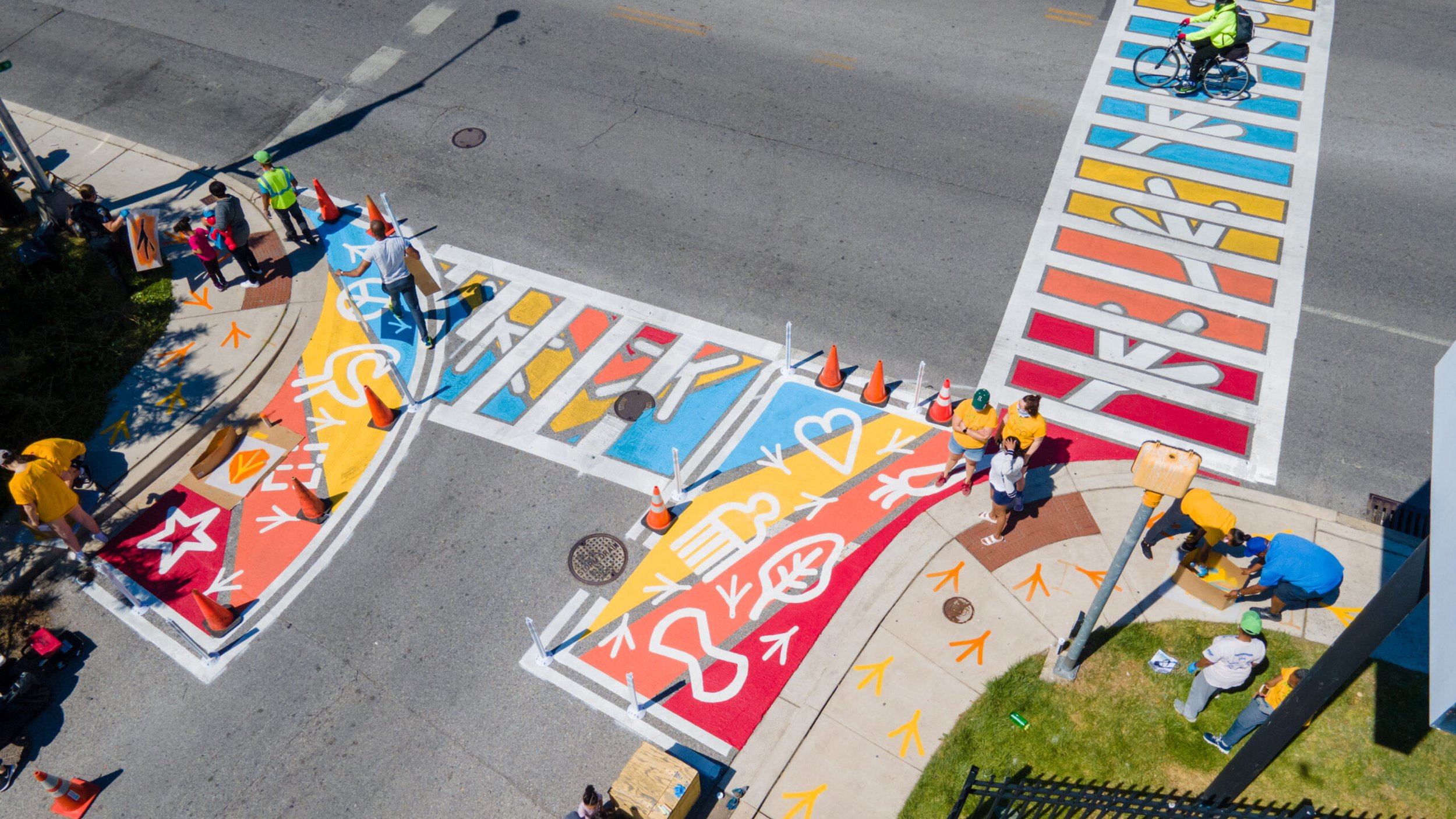Tactical Urbanism in Baltimore Yields Safer Streets, Inspiring Art
(Source: Graham Projects.)
The first thing you notice is a colorful array of stenciled leaves covering the sidewalk. Follow them and you’ll soon be astride a crosswalk of geometric shapes in vibrant colors, before linking up with another decorated sidewalk on the other side. In the process, you’ll have crossed six lanes of traffic obstructing access to one of Baltimore’s biggest and oldest parks.
On a small scale, it’s a safety enhancement with a touch of whimsy. But seen in a broader context, it’s an attempt to reclaim an urban landscape that has been made inhospitable by cars, and by the fraught planning practices that enabled them.
Graham Coreil-Allen, who calls himself a “social practice artist,” designed and executed this project. For this design in Druid Hill Park, he was working in a neighborhood that had been cleaved from the park that anchored it by decades of transportation engineers prioritizing through-traffic. His methods marry art, engineering, and close community interaction. “We went out into the neighborhood and we asked folks to nominate their favorite types of tree … We took those leaves and we turned them into the artwork that now helps to bridge the highway, at least visually further reinforcing the pedestrian’s right of way during the traffic cycle,” says Coreil-Allen.
Coreil-Allen’s firm is often brought in to consult on neighborhood projects with variable budgets and scopes. But one thing he consistently finds is the need to remedy a dangerous transportation system. In Baltimore, that design includes a racial history as highway building prioritized moving cars through existing urban neighborhoods to outlying suburbs. “The streets are in the essential most public space of a community. And so they really should be privileging the community members who live there first,” says Coreil-Allen.
His projects often involve traffic calming or reclaiming pavement. The planning process prioritizes “making sure that folks can walk around, first and foremost, and have that same level of convenience and safety as car drivers, as a way to even the playing field.”
A design in the Remington Neighborhood uses planters, poles, and paint to enchanting effect. A parklet was claimed from an unusually shaped, unregulated five-way intersection. On the facing side, paint and poles help narrow and square off a dangerous curved curb. Another project Coreil-Allen is proud of is called Seasonal Turn in the Reservoir Hill Neighborhood. Curb extensions and flex poles narrow the intersection, while the artwork is a “spinning aperture of different colors that represents a changing of the seasons and the diversity of the neighborhood,” he says.
Coreil-Allen participated in several projects for Baltimore’s Curbside Commons initiative which aimed to expand public spaces during the pandemic. While some have been disbanded, the city has created a program to allow neighborhoods to maintain those spaces with a sliding scale to help keep them affordable. Like many design professionals, Coreil-Allen observed a shifting in priorities during the pandemic era as people noticed “how much extra space we have taken by cars, or at least reserved for cars. And so by transforming even just a small amount of that into public spaces, you can really add a lot to a neighborhood and help out small businesses and create places for interaction.” He says cities need to start looking at their long-term capital planning processes to keep “these very much-needed public spaces.”
Coreil-Allen notes that tactical urbanism can play a vital role in the city ecosystem. Because of the long time horizon for municipal engineering projects, even neighborhoods that might be slated for major improvement projects still have a long stretch with their existing problems. But a neighborhood with a safety grant could hire a firm like his for a traffic-calming project that “will take 12 to 18 months to perform. And, and that's what we're really proud of, we're trying to work within the means of a community and and help them effect change in a hands-on way.”
A recent project in East Baltimore started with a grim milestone. The intersection of Biddle and Bond had been the scene of a fatal accident, and friends and neighbors had decorated a tree pit in the victim’s honor. Coreil-Allen called it a “profound reminder of what it is we're trying to prevent.” Traffic-calming was executed using curb extensions, poles, and paint, but the art provided a special connection to the community.
Coreil-Allen’s firm solicited designs from the neighborhood, and were moved by a girl’s drawing of an eye crying a rainbow. After an approval process, that girl’s concept is now the focal point of the installation. An aerial view shows a vivid eye at each corner, with the rainbow extending onto the sidewalk. After artists stenciled the design, the neighborhood was invited to help paint it, thus offering an “opportunity for the community members to have a hand in making the artwork and thereby building ownership in the public space,” says Coreil-Allen.















Advocates must adjust the way they talk about city planning. Overuse of jargon and a strict focus on logical debate alienates people, but focusing on the concrete benefits of better urban design — or, even better, showing those benefits — can make change more appealing.